Individual Performance Objectives and Key Concepts in Management
VerifiedAdded on 2023/06/12
|10
|2023
|360
Essay
AI Summary
This essay explores key concepts in performance management, focusing on the role of individual performance objectives and their alignment with organizational strategic goals. It discusses cost-benefit analysis of HRM programs, the use of 360-degree feedback, and the impact of reward systems on employee motivation. The essay also reflects on the importance of communication between HR managers and line managers in improving staffing processes and developing workforce strategies. Additionally, the author shares personal experiences and skills gained in various roles, emphasizing teamwork, employee motivation, and continuous improvement, while also acknowledging areas for further development such as customer service skills. Desklib provides access to similar solved assignments and study resources for students.
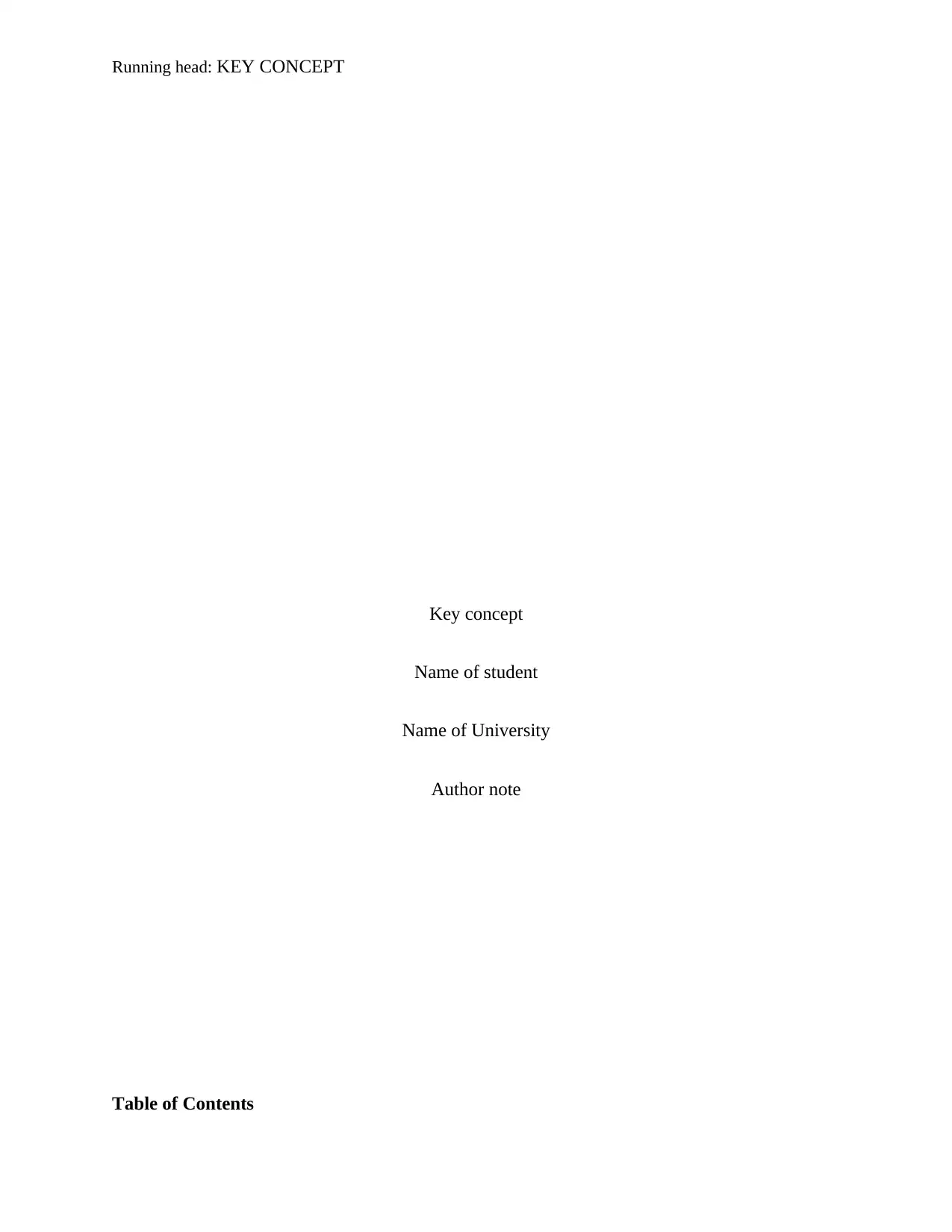
Running head: KEY CONCEPT
Key concept
Name of student
Name of University
Author note
Table of Contents
Key concept
Name of student
Name of University
Author note
Table of Contents
Paraphrase This Document
Need a fresh take? Get an instant paraphrase of this document with our AI Paraphraser
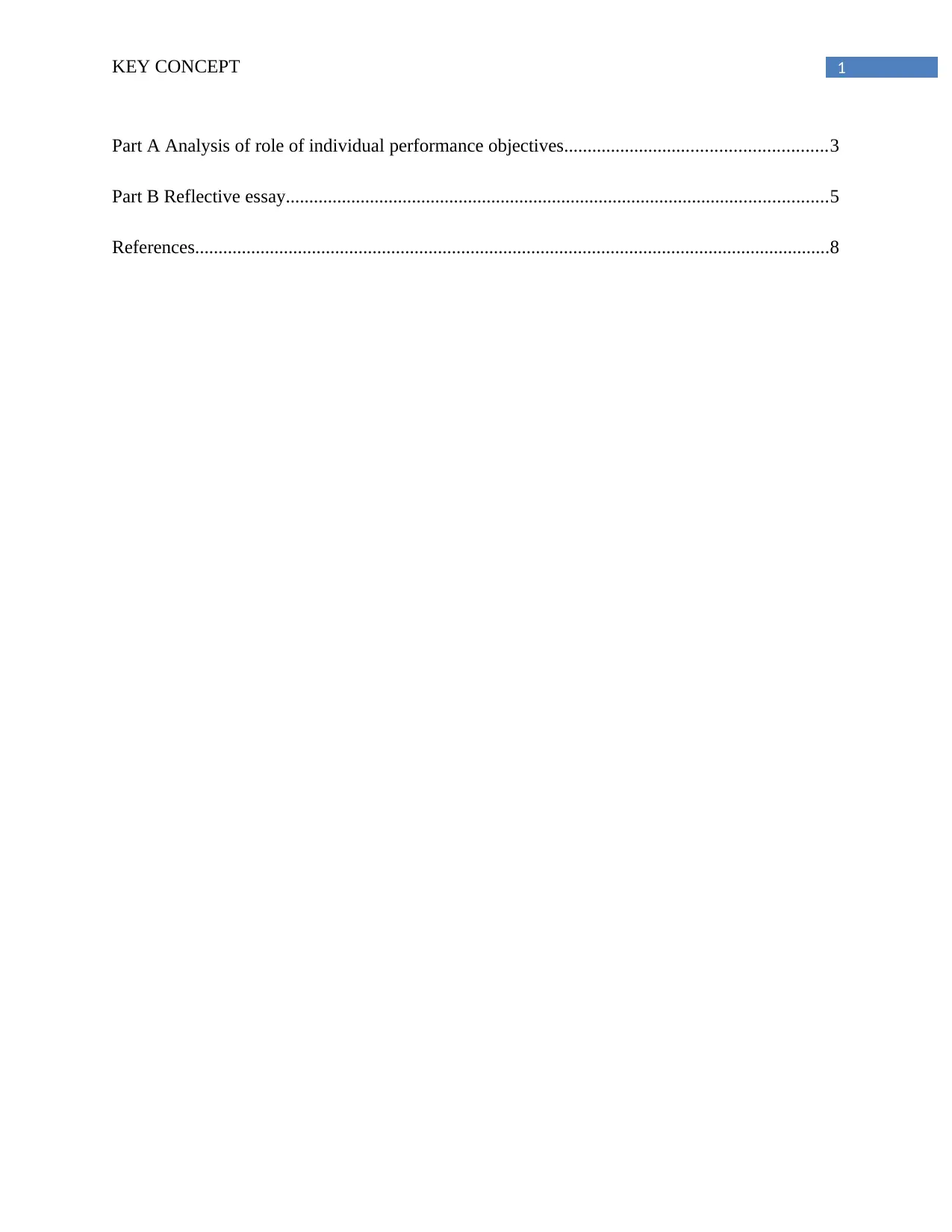
1KEY CONCEPT
Part A Analysis of role of individual performance objectives........................................................3
Part B Reflective essay....................................................................................................................5
References........................................................................................................................................8
Part A Analysis of role of individual performance objectives........................................................3
Part B Reflective essay....................................................................................................................5
References........................................................................................................................................8
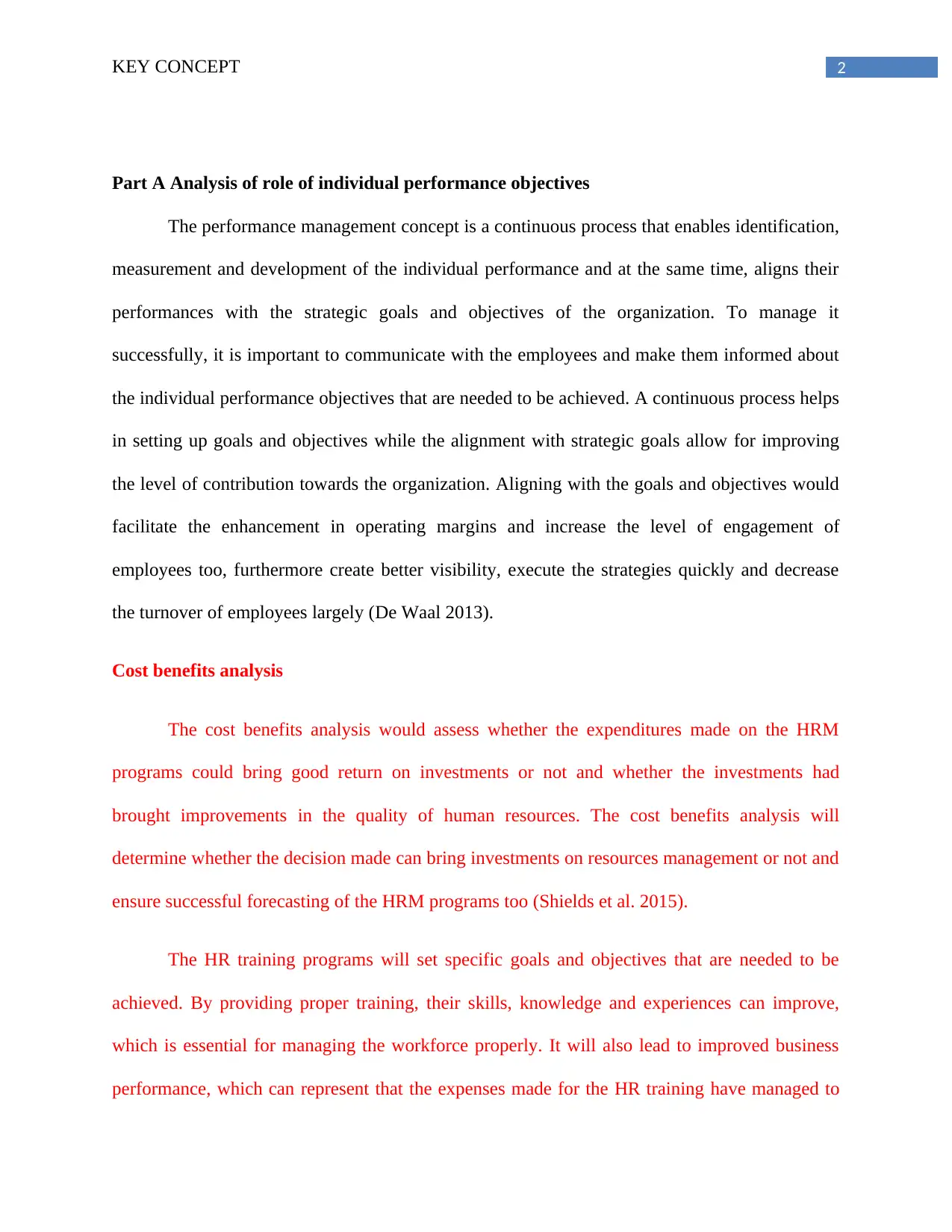
2KEY CONCEPT
Part A Analysis of role of individual performance objectives
The performance management concept is a continuous process that enables identification,
measurement and development of the individual performance and at the same time, aligns their
performances with the strategic goals and objectives of the organization. To manage it
successfully, it is important to communicate with the employees and make them informed about
the individual performance objectives that are needed to be achieved. A continuous process helps
in setting up goals and objectives while the alignment with strategic goals allow for improving
the level of contribution towards the organization. Aligning with the goals and objectives would
facilitate the enhancement in operating margins and increase the level of engagement of
employees too, furthermore create better visibility, execute the strategies quickly and decrease
the turnover of employees largely (De Waal 2013).
Cost benefits analysis
The cost benefits analysis would assess whether the expenditures made on the HRM
programs could bring good return on investments or not and whether the investments had
brought improvements in the quality of human resources. The cost benefits analysis will
determine whether the decision made can bring investments on resources management or not and
ensure successful forecasting of the HRM programs too (Shields et al. 2015).
The HR training programs will set specific goals and objectives that are needed to be
achieved. By providing proper training, their skills, knowledge and experiences can improve,
which is essential for managing the workforce properly. It will also lead to improved business
performance, which can represent that the expenses made for the HR training have managed to
Part A Analysis of role of individual performance objectives
The performance management concept is a continuous process that enables identification,
measurement and development of the individual performance and at the same time, aligns their
performances with the strategic goals and objectives of the organization. To manage it
successfully, it is important to communicate with the employees and make them informed about
the individual performance objectives that are needed to be achieved. A continuous process helps
in setting up goals and objectives while the alignment with strategic goals allow for improving
the level of contribution towards the organization. Aligning with the goals and objectives would
facilitate the enhancement in operating margins and increase the level of engagement of
employees too, furthermore create better visibility, execute the strategies quickly and decrease
the turnover of employees largely (De Waal 2013).
Cost benefits analysis
The cost benefits analysis would assess whether the expenditures made on the HRM
programs could bring good return on investments or not and whether the investments had
brought improvements in the quality of human resources. The cost benefits analysis will
determine whether the decision made can bring investments on resources management or not and
ensure successful forecasting of the HRM programs too (Shields et al. 2015).
The HR training programs will set specific goals and objectives that are needed to be
achieved. By providing proper training, their skills, knowledge and experiences can improve,
which is essential for managing the workforce properly. It will also lead to improved business
performance, which can represent that the expenses made for the HR training have managed to
⊘ This is a preview!⊘
Do you want full access?
Subscribe today to unlock all pages.

Trusted by 1+ million students worldwide
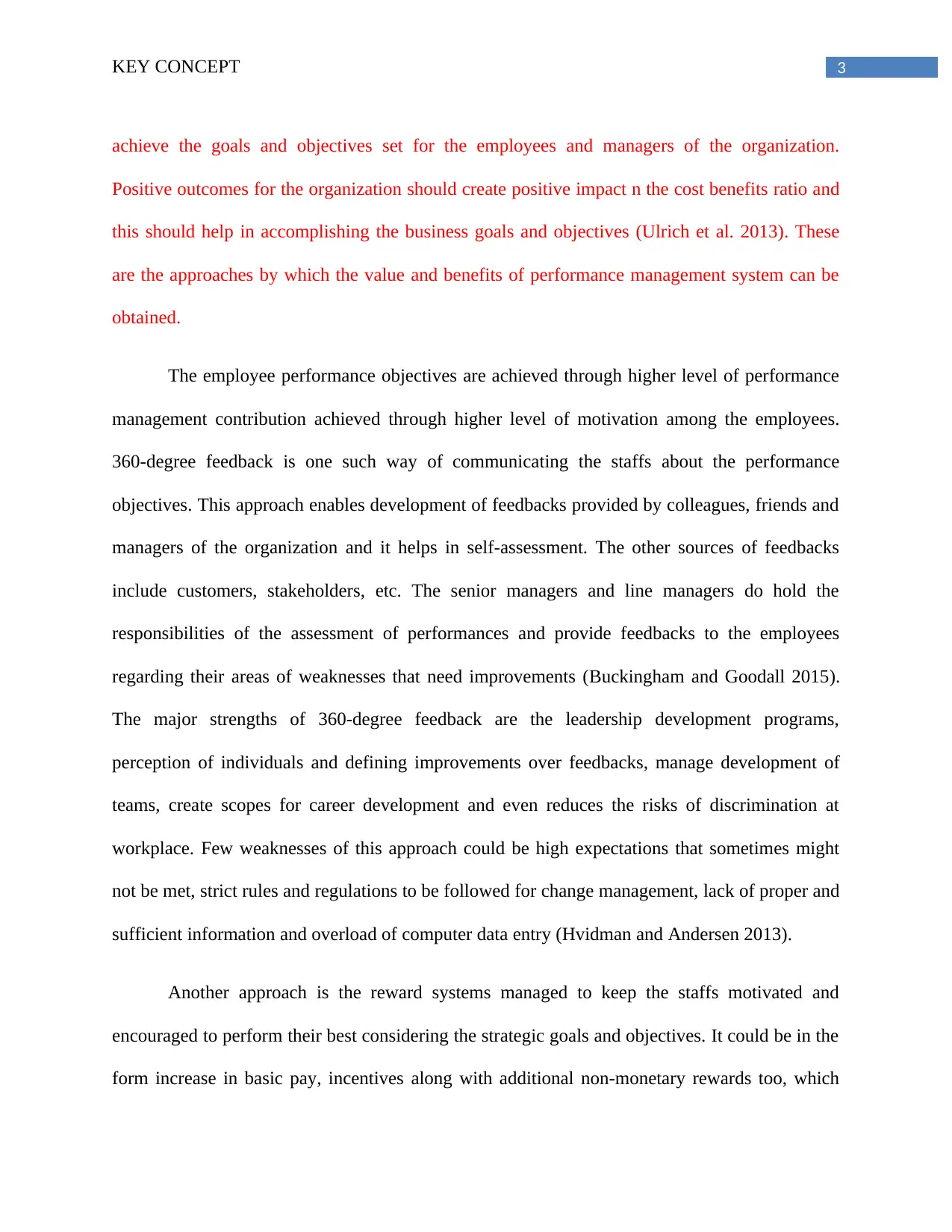
3KEY CONCEPT
achieve the goals and objectives set for the employees and managers of the organization.
Positive outcomes for the organization should create positive impact n the cost benefits ratio and
this should help in accomplishing the business goals and objectives (Ulrich et al. 2013). These
are the approaches by which the value and benefits of performance management system can be
obtained.
The employee performance objectives are achieved through higher level of performance
management contribution achieved through higher level of motivation among the employees.
360-degree feedback is one such way of communicating the staffs about the performance
objectives. This approach enables development of feedbacks provided by colleagues, friends and
managers of the organization and it helps in self-assessment. The other sources of feedbacks
include customers, stakeholders, etc. The senior managers and line managers do hold the
responsibilities of the assessment of performances and provide feedbacks to the employees
regarding their areas of weaknesses that need improvements (Buckingham and Goodall 2015).
The major strengths of 360-degree feedback are the leadership development programs,
perception of individuals and defining improvements over feedbacks, manage development of
teams, create scopes for career development and even reduces the risks of discrimination at
workplace. Few weaknesses of this approach could be high expectations that sometimes might
not be met, strict rules and regulations to be followed for change management, lack of proper and
sufficient information and overload of computer data entry (Hvidman and Andersen 2013).
Another approach is the reward systems managed to keep the staffs motivated and
encouraged to perform their best considering the strategic goals and objectives. It could be in the
form increase in basic pay, incentives along with additional non-monetary rewards too, which
achieve the goals and objectives set for the employees and managers of the organization.
Positive outcomes for the organization should create positive impact n the cost benefits ratio and
this should help in accomplishing the business goals and objectives (Ulrich et al. 2013). These
are the approaches by which the value and benefits of performance management system can be
obtained.
The employee performance objectives are achieved through higher level of performance
management contribution achieved through higher level of motivation among the employees.
360-degree feedback is one such way of communicating the staffs about the performance
objectives. This approach enables development of feedbacks provided by colleagues, friends and
managers of the organization and it helps in self-assessment. The other sources of feedbacks
include customers, stakeholders, etc. The senior managers and line managers do hold the
responsibilities of the assessment of performances and provide feedbacks to the employees
regarding their areas of weaknesses that need improvements (Buckingham and Goodall 2015).
The major strengths of 360-degree feedback are the leadership development programs,
perception of individuals and defining improvements over feedbacks, manage development of
teams, create scopes for career development and even reduces the risks of discrimination at
workplace. Few weaknesses of this approach could be high expectations that sometimes might
not be met, strict rules and regulations to be followed for change management, lack of proper and
sufficient information and overload of computer data entry (Hvidman and Andersen 2013).
Another approach is the reward systems managed to keep the staffs motivated and
encouraged to perform their best considering the strategic goals and objectives. It could be in the
form increase in basic pay, incentives along with additional non-monetary rewards too, which
Paraphrase This Document
Need a fresh take? Get an instant paraphrase of this document with our AI Paraphraser

4KEY CONCEPT
would keep them motivated to work according to plans and deliver the best performance to
achieve the corporate strategic goals and objectives with ease. The managers will communicate
the employees about the things that they need to do and what benefits they can obtain from the
organization. It can create a healthy competition, because when one employee will perform to his
potential and gain rewards, others will be motivated to work harder as well (Shields et al. 2015).
The weaknesses of this approach could be the resentment of employees and focusing only on
getting awards can sometimes make them lose focus on the actual goals and commitment to the
organization.
The 360-degree feedback works as a charm, because the feedbacks on employee
performances help in identifying the areas that needed improvements. In case an employee fails
to provide the desired work for which he has been assigned for, then the feedbacks can make
them work on certain areas and rectify themselves to accomplish the business goals and
objectives (Nielsen 2013).
The relationship between HR managers and line managers could help in improving the
staffing process as well as develop workforce related strategies through training and
developmental sessions for improving the skills and knowledge of the employees. The managers
communicate with the line managers, who communicate the messages and information to the
staffs. The training and development is an effective HR function that improves the line
manager’s ability to conduct performance appraisal and provide employees with constructive
feedbacks. It can result in higher employee satisfaction, resolve conflicts and ensure
collaborative team working too (Khamooshi and Golafshani 2013). Performance planning will be
possible by identifying the key performance indicators too by assessing the production output,
would keep them motivated to work according to plans and deliver the best performance to
achieve the corporate strategic goals and objectives with ease. The managers will communicate
the employees about the things that they need to do and what benefits they can obtain from the
organization. It can create a healthy competition, because when one employee will perform to his
potential and gain rewards, others will be motivated to work harder as well (Shields et al. 2015).
The weaknesses of this approach could be the resentment of employees and focusing only on
getting awards can sometimes make them lose focus on the actual goals and commitment to the
organization.
The 360-degree feedback works as a charm, because the feedbacks on employee
performances help in identifying the areas that needed improvements. In case an employee fails
to provide the desired work for which he has been assigned for, then the feedbacks can make
them work on certain areas and rectify themselves to accomplish the business goals and
objectives (Nielsen 2013).
The relationship between HR managers and line managers could help in improving the
staffing process as well as develop workforce related strategies through training and
developmental sessions for improving the skills and knowledge of the employees. The managers
communicate with the line managers, who communicate the messages and information to the
staffs. The training and development is an effective HR function that improves the line
manager’s ability to conduct performance appraisal and provide employees with constructive
feedbacks. It can result in higher employee satisfaction, resolve conflicts and ensure
collaborative team working too (Khamooshi and Golafshani 2013). Performance planning will be
possible by identifying the key performance indicators too by assessing the production output,
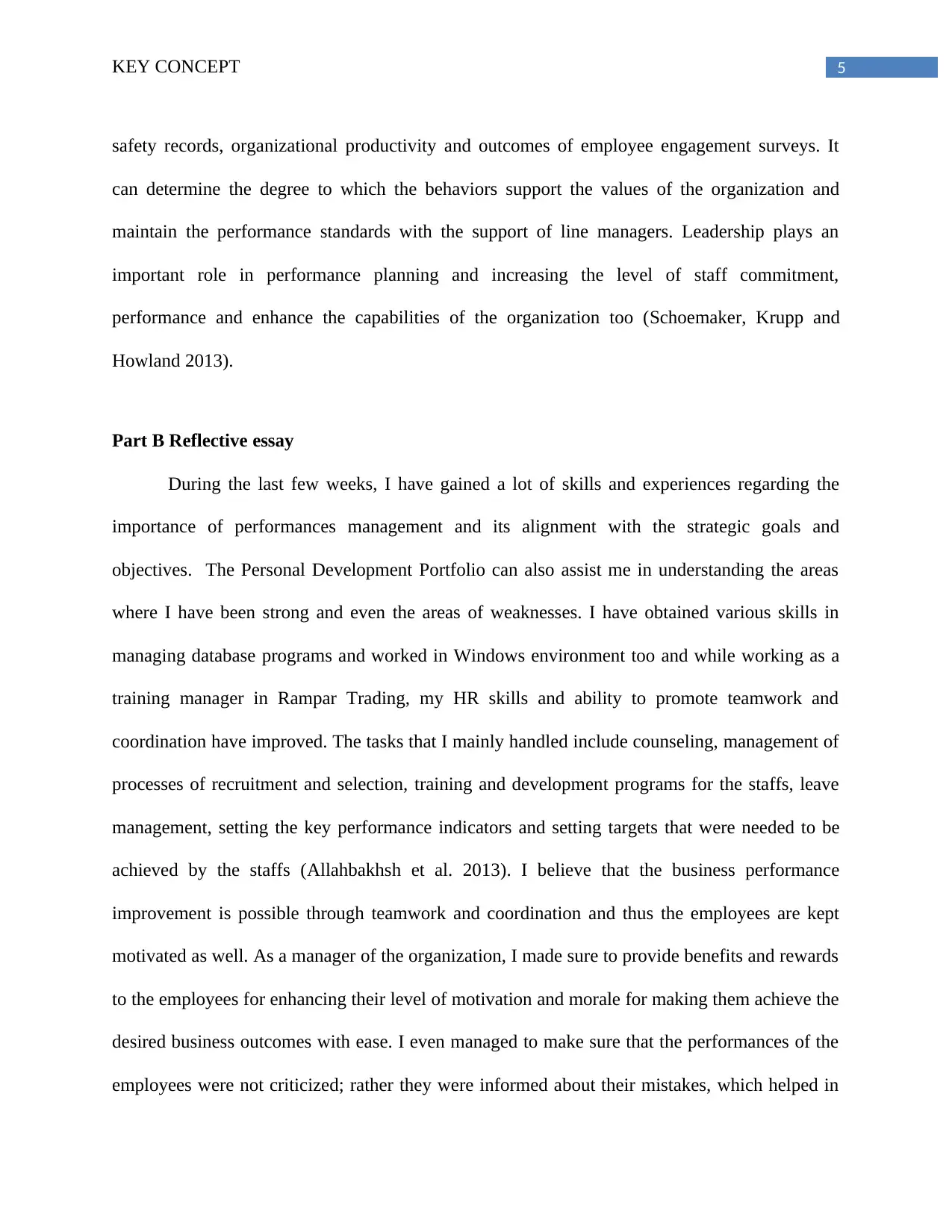
5KEY CONCEPT
safety records, organizational productivity and outcomes of employee engagement surveys. It
can determine the degree to which the behaviors support the values of the organization and
maintain the performance standards with the support of line managers. Leadership plays an
important role in performance planning and increasing the level of staff commitment,
performance and enhance the capabilities of the organization too (Schoemaker, Krupp and
Howland 2013).
Part B Reflective essay
During the last few weeks, I have gained a lot of skills and experiences regarding the
importance of performances management and its alignment with the strategic goals and
objectives. The Personal Development Portfolio can also assist me in understanding the areas
where I have been strong and even the areas of weaknesses. I have obtained various skills in
managing database programs and worked in Windows environment too and while working as a
training manager in Rampar Trading, my HR skills and ability to promote teamwork and
coordination have improved. The tasks that I mainly handled include counseling, management of
processes of recruitment and selection, training and development programs for the staffs, leave
management, setting the key performance indicators and setting targets that were needed to be
achieved by the staffs (Allahbakhsh et al. 2013). I believe that the business performance
improvement is possible through teamwork and coordination and thus the employees are kept
motivated as well. As a manager of the organization, I made sure to provide benefits and rewards
to the employees for enhancing their level of motivation and morale for making them achieve the
desired business outcomes with ease. I even managed to make sure that the performances of the
employees were not criticized; rather they were informed about their mistakes, which helped in
safety records, organizational productivity and outcomes of employee engagement surveys. It
can determine the degree to which the behaviors support the values of the organization and
maintain the performance standards with the support of line managers. Leadership plays an
important role in performance planning and increasing the level of staff commitment,
performance and enhance the capabilities of the organization too (Schoemaker, Krupp and
Howland 2013).
Part B Reflective essay
During the last few weeks, I have gained a lot of skills and experiences regarding the
importance of performances management and its alignment with the strategic goals and
objectives. The Personal Development Portfolio can also assist me in understanding the areas
where I have been strong and even the areas of weaknesses. I have obtained various skills in
managing database programs and worked in Windows environment too and while working as a
training manager in Rampar Trading, my HR skills and ability to promote teamwork and
coordination have improved. The tasks that I mainly handled include counseling, management of
processes of recruitment and selection, training and development programs for the staffs, leave
management, setting the key performance indicators and setting targets that were needed to be
achieved by the staffs (Allahbakhsh et al. 2013). I believe that the business performance
improvement is possible through teamwork and coordination and thus the employees are kept
motivated as well. As a manager of the organization, I made sure to provide benefits and rewards
to the employees for enhancing their level of motivation and morale for making them achieve the
desired business outcomes with ease. I even managed to make sure that the performances of the
employees were not criticized; rather they were informed about their mistakes, which helped in
⊘ This is a preview!⊘
Do you want full access?
Subscribe today to unlock all pages.

Trusted by 1+ million students worldwide
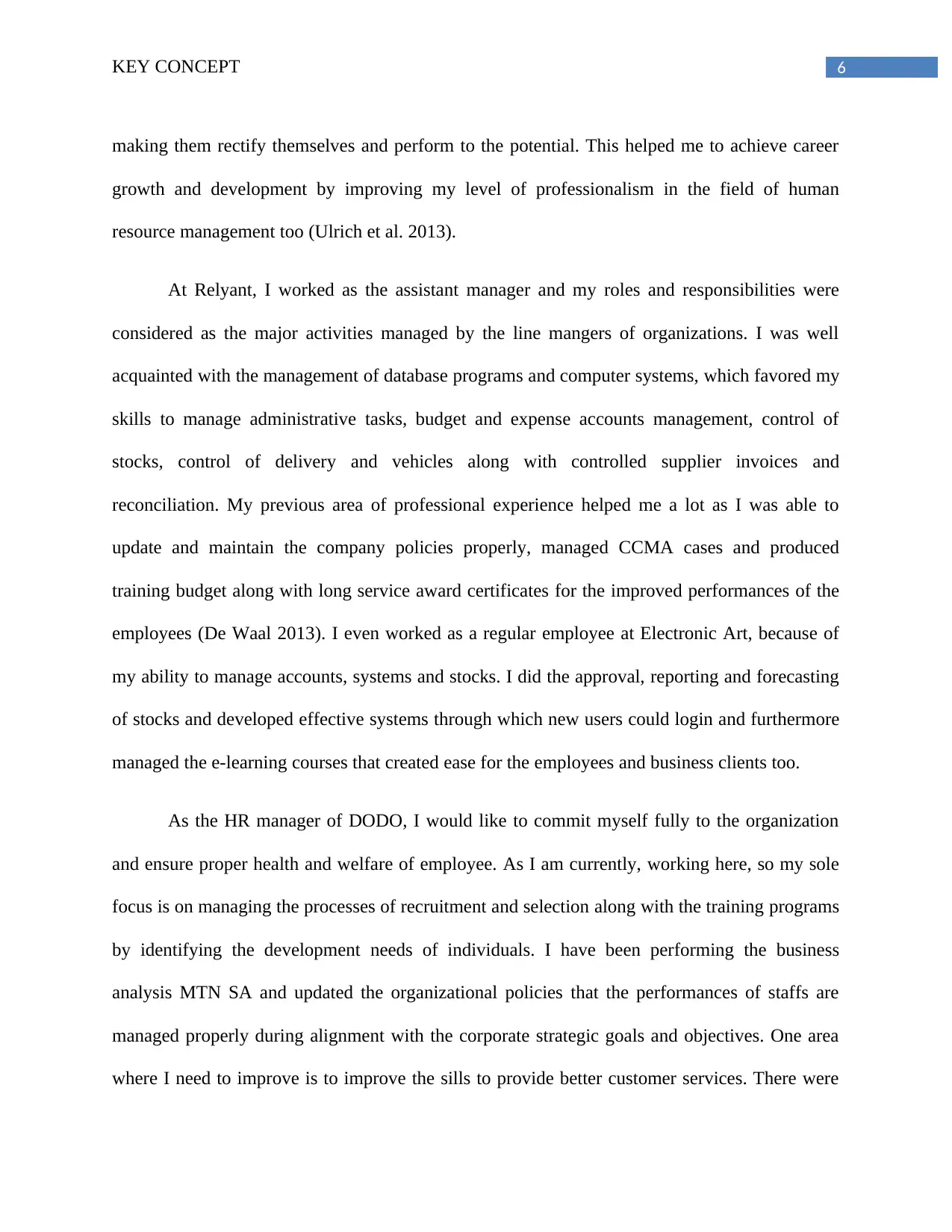
6KEY CONCEPT
making them rectify themselves and perform to the potential. This helped me to achieve career
growth and development by improving my level of professionalism in the field of human
resource management too (Ulrich et al. 2013).
At Relyant, I worked as the assistant manager and my roles and responsibilities were
considered as the major activities managed by the line mangers of organizations. I was well
acquainted with the management of database programs and computer systems, which favored my
skills to manage administrative tasks, budget and expense accounts management, control of
stocks, control of delivery and vehicles along with controlled supplier invoices and
reconciliation. My previous area of professional experience helped me a lot as I was able to
update and maintain the company policies properly, managed CCMA cases and produced
training budget along with long service award certificates for the improved performances of the
employees (De Waal 2013). I even worked as a regular employee at Electronic Art, because of
my ability to manage accounts, systems and stocks. I did the approval, reporting and forecasting
of stocks and developed effective systems through which new users could login and furthermore
managed the e-learning courses that created ease for the employees and business clients too.
As the HR manager of DODO, I would like to commit myself fully to the organization
and ensure proper health and welfare of employee. As I am currently, working here, so my sole
focus is on managing the processes of recruitment and selection along with the training programs
by identifying the development needs of individuals. I have been performing the business
analysis MTN SA and updated the organizational policies that the performances of staffs are
managed properly during alignment with the corporate strategic goals and objectives. One area
where I need to improve is to improve the sills to provide better customer services. There were
making them rectify themselves and perform to the potential. This helped me to achieve career
growth and development by improving my level of professionalism in the field of human
resource management too (Ulrich et al. 2013).
At Relyant, I worked as the assistant manager and my roles and responsibilities were
considered as the major activities managed by the line mangers of organizations. I was well
acquainted with the management of database programs and computer systems, which favored my
skills to manage administrative tasks, budget and expense accounts management, control of
stocks, control of delivery and vehicles along with controlled supplier invoices and
reconciliation. My previous area of professional experience helped me a lot as I was able to
update and maintain the company policies properly, managed CCMA cases and produced
training budget along with long service award certificates for the improved performances of the
employees (De Waal 2013). I even worked as a regular employee at Electronic Art, because of
my ability to manage accounts, systems and stocks. I did the approval, reporting and forecasting
of stocks and developed effective systems through which new users could login and furthermore
managed the e-learning courses that created ease for the employees and business clients too.
As the HR manager of DODO, I would like to commit myself fully to the organization
and ensure proper health and welfare of employee. As I am currently, working here, so my sole
focus is on managing the processes of recruitment and selection along with the training programs
by identifying the development needs of individuals. I have been performing the business
analysis MTN SA and updated the organizational policies that the performances of staffs are
managed properly during alignment with the corporate strategic goals and objectives. One area
where I need to improve is to improve the sills to provide better customer services. There were
Paraphrase This Document
Need a fresh take? Get an instant paraphrase of this document with our AI Paraphraser

7KEY CONCEPT
situations when the shoes delivered to the clients were found to be faulty and the customer
service department did not provide proper services, due to which there were several complaints
(Ulrich et al. 2013). I will like to work in this area and make necessary improvements to ensure
achieving the organizational standards and deliver extensive customers’ services for increasing
their level of satisfaction. This can improve my own skills and assist me in professional growth
in the future.
References
situations when the shoes delivered to the clients were found to be faulty and the customer
service department did not provide proper services, due to which there were several complaints
(Ulrich et al. 2013). I will like to work in this area and make necessary improvements to ensure
achieving the organizational standards and deliver extensive customers’ services for increasing
their level of satisfaction. This can improve my own skills and assist me in professional growth
in the future.
References
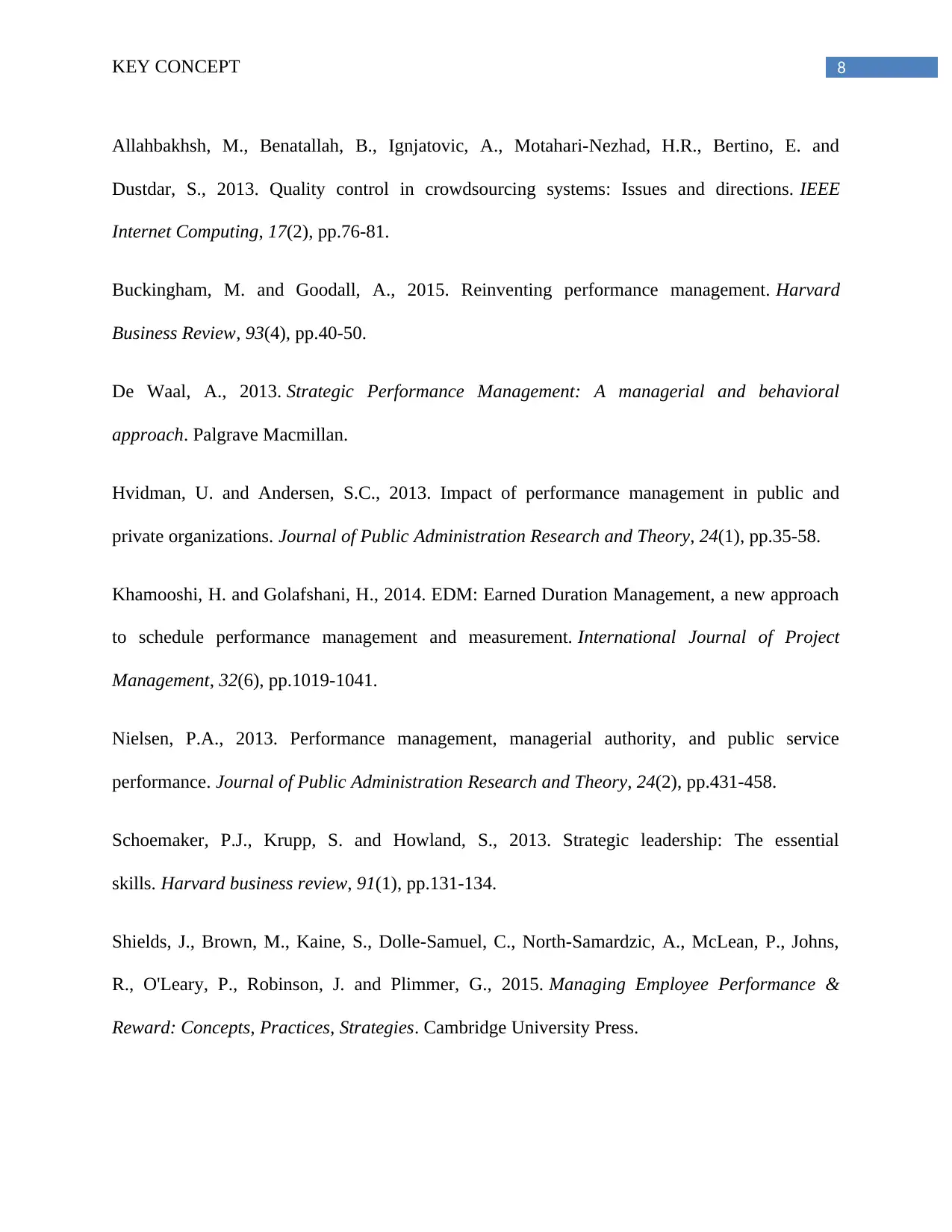
8KEY CONCEPT
Allahbakhsh, M., Benatallah, B., Ignjatovic, A., Motahari-Nezhad, H.R., Bertino, E. and
Dustdar, S., 2013. Quality control in crowdsourcing systems: Issues and directions. IEEE
Internet Computing, 17(2), pp.76-81.
Buckingham, M. and Goodall, A., 2015. Reinventing performance management. Harvard
Business Review, 93(4), pp.40-50.
De Waal, A., 2013. Strategic Performance Management: A managerial and behavioral
approach. Palgrave Macmillan.
Hvidman, U. and Andersen, S.C., 2013. Impact of performance management in public and
private organizations. Journal of Public Administration Research and Theory, 24(1), pp.35-58.
Khamooshi, H. and Golafshani, H., 2014. EDM: Earned Duration Management, a new approach
to schedule performance management and measurement. International Journal of Project
Management, 32(6), pp.1019-1041.
Nielsen, P.A., 2013. Performance management, managerial authority, and public service
performance. Journal of Public Administration Research and Theory, 24(2), pp.431-458.
Schoemaker, P.J., Krupp, S. and Howland, S., 2013. Strategic leadership: The essential
skills. Harvard business review, 91(1), pp.131-134.
Shields, J., Brown, M., Kaine, S., Dolle-Samuel, C., North-Samardzic, A., McLean, P., Johns,
R., O'Leary, P., Robinson, J. and Plimmer, G., 2015. Managing Employee Performance &
Reward: Concepts, Practices, Strategies. Cambridge University Press.
Allahbakhsh, M., Benatallah, B., Ignjatovic, A., Motahari-Nezhad, H.R., Bertino, E. and
Dustdar, S., 2013. Quality control in crowdsourcing systems: Issues and directions. IEEE
Internet Computing, 17(2), pp.76-81.
Buckingham, M. and Goodall, A., 2015. Reinventing performance management. Harvard
Business Review, 93(4), pp.40-50.
De Waal, A., 2013. Strategic Performance Management: A managerial and behavioral
approach. Palgrave Macmillan.
Hvidman, U. and Andersen, S.C., 2013. Impact of performance management in public and
private organizations. Journal of Public Administration Research and Theory, 24(1), pp.35-58.
Khamooshi, H. and Golafshani, H., 2014. EDM: Earned Duration Management, a new approach
to schedule performance management and measurement. International Journal of Project
Management, 32(6), pp.1019-1041.
Nielsen, P.A., 2013. Performance management, managerial authority, and public service
performance. Journal of Public Administration Research and Theory, 24(2), pp.431-458.
Schoemaker, P.J., Krupp, S. and Howland, S., 2013. Strategic leadership: The essential
skills. Harvard business review, 91(1), pp.131-134.
Shields, J., Brown, M., Kaine, S., Dolle-Samuel, C., North-Samardzic, A., McLean, P., Johns,
R., O'Leary, P., Robinson, J. and Plimmer, G., 2015. Managing Employee Performance &
Reward: Concepts, Practices, Strategies. Cambridge University Press.
⊘ This is a preview!⊘
Do you want full access?
Subscribe today to unlock all pages.

Trusted by 1+ million students worldwide
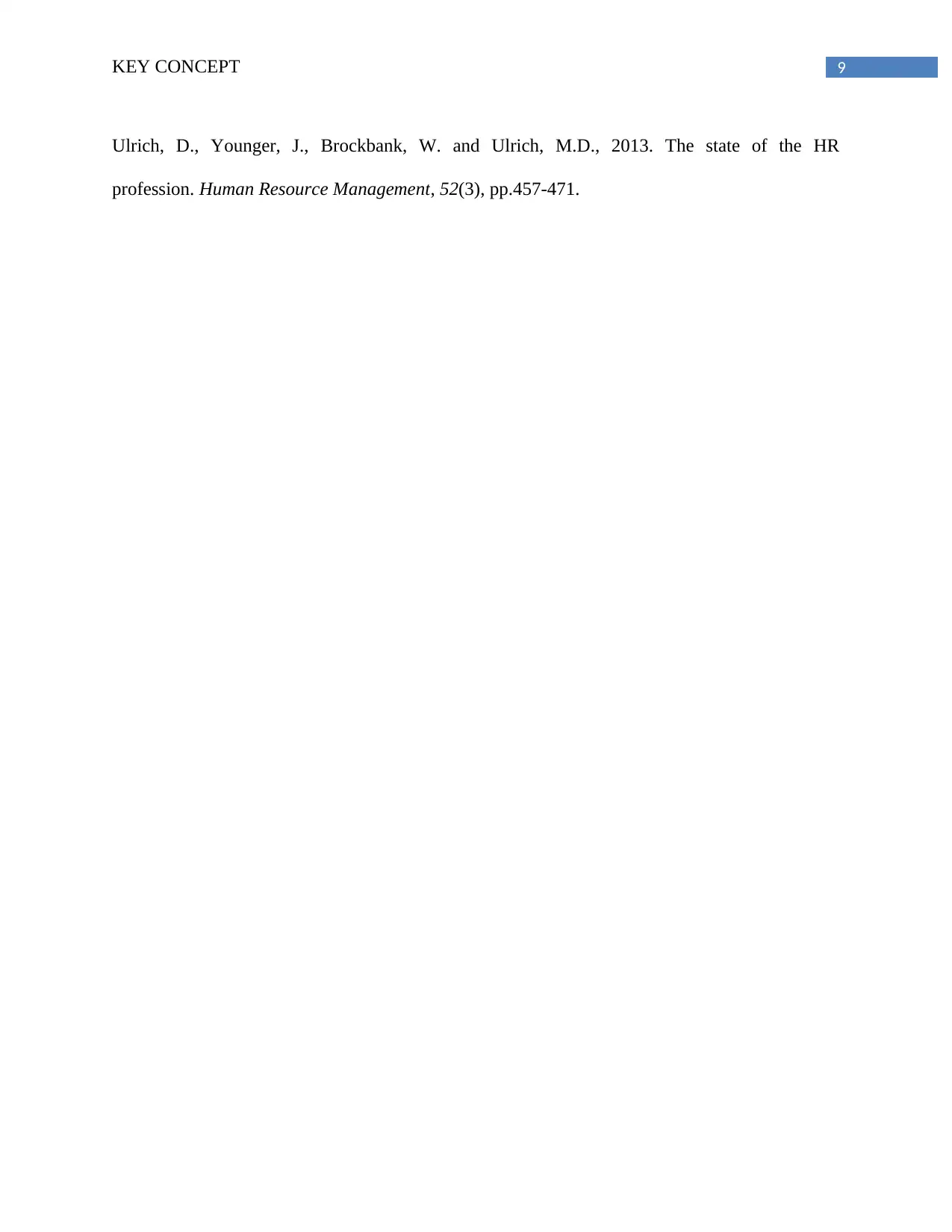
9KEY CONCEPT
Ulrich, D., Younger, J., Brockbank, W. and Ulrich, M.D., 2013. The state of the HR
profession. Human Resource Management, 52(3), pp.457-471.
Ulrich, D., Younger, J., Brockbank, W. and Ulrich, M.D., 2013. The state of the HR
profession. Human Resource Management, 52(3), pp.457-471.
1 out of 10
Related Documents
Your All-in-One AI-Powered Toolkit for Academic Success.
+13062052269
info@desklib.com
Available 24*7 on WhatsApp / Email
![[object Object]](/_next/static/media/star-bottom.7253800d.svg)
Unlock your academic potential
Copyright © 2020–2025 A2Z Services. All Rights Reserved. Developed and managed by ZUCOL.




